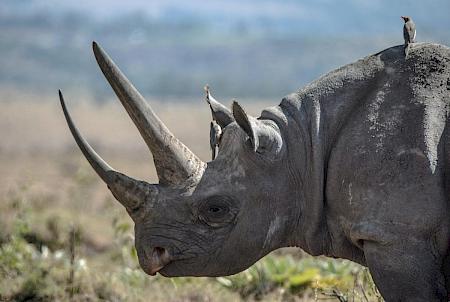Rhino poaching and illegal trade decline but remain critical threats – new report
Joint Press Release IUCN / TRAFFIC – Overall rhino poaching rates have declined since 2018, and trade data suggests the lowest annual estimate of rhino horns entering illegal trade markets since 2013, according to a new report by the IUCN SSC African and Asian Rhino Specialist Groups and TRAFFIC for the 19th meeting of the Conference of the Parties to the Convention on International Trade in Endangered Species of Wild Fauna and Flora (CITES), which will be held in Panama in November this year.
“The overall decline in poaching of rhinos is encouraging, yet this remains an acute threat to the survival of these iconic animals,” said Sam Ferreira, Scientific Officer with the IUCN SSC African Rhino Specialist Group. “To support the growth of rhino numbers, it is essential to continue active population management and anti-poaching activities for all subspecies across different range states.”

The report finds that rhino poaching rates in Africa have continued to decline from a peak of 5.3% of the total population in 2015 to 2.3% in 2021. At least 2,707 rhinos were poached across Africa between 2018 and 2021, accounting for both the white rhino (Ceratotherium simum), which is Near Threatened on the IUCN Red List of Threatened Species™, and the rarer Critically Endangered black rhino (Diceros bicornis). South Africa accounted for 90% of all reported cases, predominantly affecting white rhinos in Kruger National Park, home to the world’s largest white rhino population. As a result, overall white rhino numbers on the continent have declined by almost 12% (from 18,067 to 15,942 individuals) during this period, while populations of black rhino increased by just over 12% (from 5,495 to 6,195 individuals). Overall, Africa’s rhino population declined around 1.6% per year, from an estimated 23,562 individuals in 2018 to 22,137 at the end of 2021.
According to the report, global lockdowns and restrictions due to the COVID-19 pandemic saw several African countries experience dramatically reduced poaching rates in 2020 compared to previous years. South Africa lost 394 rhinos to poaching in 2020, while Kenya recorded no rhino poaching that year. However, as COVID-19 travel restrictions lifted, some range states reported new increases in poaching activities – for example, South Africa reported 451 and Kenya six poached rhinos in 2021. However, these numbers are still significantly lower than during the peak in 2015, when South Africa alone lost 1,175 rhinos to poaching.
Alongside the decline in poaching, data analysed for range and consumer states suggests that, on average, between 575 and 923 African rhino horns entered illegal trade markets each year between 2018 and 2020, compared to approximately 1,832 per year between 2016 and 2017. However, in 2019, before the COVID-19 outbreak, the reported seized weight of illegal rhino specimens reached its highest point of the decade, perhaps due to increased regulations and law enforcement efforts. While range and consumer countries most affected by illegal trade remained the same as in previous reports, the lack of consistent reporting by some countries still limits the ability to better understand patterns of illegal trade in rhino horns.
Overall better reporting of seizure data will help us better quantify the extent of horns entering illegal trade for future reports. Although we cannot say with exact certainty what impact COVID-19 restrictions have had on rhino horn trade, 2020 did represent an abnormal year with low levels of reported illegal activity, law enforcement, and government reporting. The continued and consistent monitoring of illegal trade is vital."
Sabri Zain, TRAFFIC Director of PolicyZain continued to highlight the need for greater sharing of critical information such as DNA samples among countries affected by the illegal trade in rhino specimens.
The report also examined Asian rhino populations. It found that populations of Vulnerable greater one-horned rhinos (Rhinoceros unicornis) and Critically Endangered Javan rhinos (Rhinoceros sondaicus) have both increased since 2017, while the Critically Endangered Sumatran rhino (Dicerorhinus sumatrensis) has suffered population declines of 13% per year. Thanks to conservation efforts including strengthened law enforcement, the number of greater one-horned rhinos in India and Nepal increased from an estimated 3,588 in 2018 to 4,014 at the end of 2021, while the total population of Javan rhinos increased from between 65 and 68 individuals in 2018 to 76 at the end of 2021. There were an estimated 34 to 47 Sumatran rhinos in 2021, compared with 40 to 78 individuals in 2018, as the small size and isolation of populations limit breeding in the wild.
The report finds that 11 rhino poaching incidents were recorded in Asia (ten in India and one in Nepal) since the beginning of 2018, all of which involved greater one-horned rhinos. Detection of carcasses in dense rainforests remains a challenge, and there were no reports of illegal killings of Sumatran rhinos despite the substantial population declines recorded. The report concludes that Asian rhino poaching declined between 2018 and 2022, continuing the trend since 2013.
Notes:
CITES Conf. 9.14 (Rev. CoP17) - Resolution on the Conservation of and Trade in African and Asian Rhinoceroses mandates IUCN and TRAFFIC to prepare a report ahead of the CITES Conference of Parties (CoP). The next, CITES CoP19, will be held in Panama in November 2022.
About IUCN

The International Union for Conservation of Nature (IUCN) is a membership Union uniquely composed of both government and civil society organisations. It provides public, private and non-governmental organisations with the knowledge and tools that enable human progress, economic development and nature conservation to take place together. For more information visit: iucn.org
About IUCN Species Survival Commission:

With over 10,500 members in 174 countries, the Species Survival Commission (SSC) is the largest of the six expert commissions of IUCN and enables IUCN to influence, encourage and assist societies to conserve biodiversity by building knowledge on the status and threats to species, providing advice, developing policies and guidelines, facilitating conservation planning, and catalysing conservation action. Learn more at www.iucn.org/ssc





